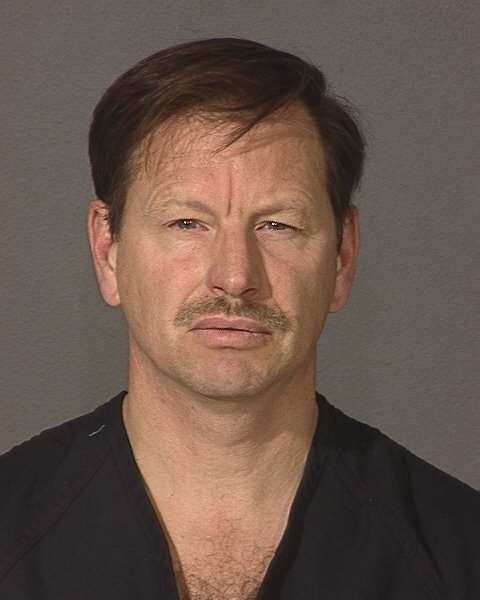Height 1.78 m Role Serial Killer | Name Gary Ridgway Country United States Children Matthew Ridgway | |
 | ||
Full Name Gary Leon Ridgway Other names The Green River KillerGreen River GaryThe River Man Victims Convicted of 49, confessed to 71, presumed to be at least 90+ Span of killings 1982–1998 confirmed, but could be as recent as 2001 Spouse Judith Lorraine Lynch (m. 1988–2002) Parents Thomas Newton Ridgway, Mary Rita Ridgway Siblings Thomas Edward Ridgway, Gregory Ridgway Similar People Ted Bundy, John Wayne Gacy, Jeffrey Dahmer, Dennis Rader, Richard Ramirez | ||
Conviction(s) MurderSolicitation | ||
Gary ridgway interview with the green river killer
Gary Leon Ridgway (born February 18, 1949) is an American serial killer known as the Green River Killer. He was initially convicted of 48 separate murders and is presumed to be responsible for more than 90. As part of his plea bargain, an additional conviction was added, bringing the total number of convictions to 49, making him the most prolific American serial killer in history according to confirmed murders. He murdered numerous women and girls in Washington State during the 1980s and 1990s.
Contents
- Gary ridgway interview with the green river killer
- The green river killer gary ridgway serial killer files 31
- Childhood
- Adult life
- Murders
- Plea bargain confessions sentencing
- Life imprisonment
- Victims
- Confirmed
- Task force victims list
- Suspected
- In artwork
- In documentaries and films non fiction
- In print non fiction
- In print fiction
- In music
- In television fiction
- References
Most of Ridgway's victims were alleged to be sex workers and other women in vulnerable situations, including underage runaways. The press gave him his nickname after the first five victims were found in the Green River before his identity was known. He strangled the women, usually by hand but sometimes using ligatures. After strangling them, he would dump their bodies in forested and overgrown areas in King County, often returning to the dead bodies to have sexual intercourse with them.

On November 30, 2001, as Ridgway was leaving the Kenworth truck factory where he worked in Renton, Washington, he was arrested for the murders of four women whose cases were linked to him through DNA evidence. As part of a plea bargain wherein he agreed to disclose the locations of still-missing women, he was spared the death penalty and received a sentence of life imprisonment without parole.

The green river killer gary ridgway serial killer files 31
Childhood

Gary Leon Ridgway was born on February 18, 1949, in Salt Lake City, Utah. He was the second of Mary and Thomas Ridgway's three sons. His home life was somewhat troubled; relatives have described his mother as domineering and have said that young Ridgway witnessed more than one violent argument between his parents. His father was a bus driver who would often complain about the presence of sex workers. When Ridgway was 16, he stabbed a six-year-old boy, who survived the attack. He had led the boy into the woods and then stabbed him through the ribs into his liver.
Adult life
Ridgway graduated from Tyee High School in 1969 and married his 19-year-old high school girlfriend, Claudia Kraig. He joined the U.S. Navy and was sent to Vietnam, where he served on board a supply ship and saw combat. During his time in the military, Ridgway began to have frequent sexual intercourse with numerous sex workers and contracted gonorrhea; although angered by this, he continued his practice without protection. While Ridgway was abroad, Kraig had an extramarital affair. The marriage ended within a year.
When questioned about Ridgway after his arrest, friends and family described him as friendly but strange. His first two marriages resulted in divorce because of infidelities by both partners. His second wife, Marcia Winslow, claimed that he had placed her in a chokehold. He had become religious during his second marriage, proselytizing door-to-door, reading the Bible aloud at work and at home, and insisting that his wife follow the strict teachings of their pastor. Ridgway would also frequently cry after sermons or reading the Bible. Ridgway continued to solicit the services of sex workers during this marriage. He also wanted his wife to participate in sex in public and inappropriate places, sometimes even in areas where his victims' bodies were later discovered.
According to women in his life, Ridgway had an insatiable sexual appetite. His three ex-wives and several ex-girlfriends reported that Ridgway demanded sex from them several times a day. Often, he would want to have sex in a public area or in the woods. Ridgway himself admitted to having a fixation with sex workers, with whom he had a love-hate relationship. He frequently complained about their presence in his neighborhood, but he also took advantage of their services regularly. It has been speculated that Ridgway was torn between his uncontrollable lusts and his staunch religious beliefs.
Murders
Throughout the 1980s and 1990s, Ridgway is believed to have murdered at least 71 women (according to Ridgway, in an interview with Sheriff Dave Reichert in 2001) near Seattle and Tacoma, Washington. His court statements later reported that he had killed so many, he lost count. A majority of the murders occurred between 1982 and 1984. The victims were believed to be either sex workers or runaways picked up along Pacific Highway South (International Blvd. 99), whom he strangled. Most of their bodies were dumped in wooded areas around the Green River, except for two confirmed and another two suspected victims found in the Portland, Oregon area. The bodies were often left in clusters, sometimes posed, usually nude. He would sometimes return to the victims' bodies and have sexual intercourse with them. Because most of the bodies were not discovered until only the skeletons remained, three victims are still unidentified. Ridgway occasionally contaminated the dump sites with gum, cigarettes, and written materials belonging to others, and he even transported a few victims' remains across state lines into Oregon to confuse the police.
Ridgway began each murder by picking up a woman, usually a sex worker. He sometimes showed the woman a picture of his son, to trick her into trusting him. After raping her, Ridgway strangled her from behind. He initially strangled them manually. However, many victims inflicted wounds and bruises on his arm while trying to defend themselves. Concerned these wounds and bruises would draw attention, Ridgway began using ligatures. He killed most victims in his home, his truck, or a secluded area. In the early 1980s, the King County Sheriff's Office formed the Green River Task Force to investigate the murders. The most notable members of the task force were Robert Keppel and Dave Reichert, who periodically interviewed incarcerated serial killer Ted Bundy in 1984. Bundy offered his opinions on the psychology, motivations, and behavior of the killer; he suggested that the killer was revisiting the dump sites to have sexual relations with his victims, which turned out to be true, and if police found a fresh grave, they should stake it out and wait for him to come back. Also contributing to the investigation was John E. Douglas, who has since written much on the subject of the Green River Killer.
Ridgway was arrested in 1982 and 2001 on charges related to prostitution. He became a suspect in the Green River killings in 1983. In 1984, Ridgway took and passed a polygraph test (quality control protocols later developed in the FBI after careful review determined that Ridgway actually failed his polygraph test), and on April 7, 1987, police took hair and saliva samples from Ridgway. Around 1985, Ridgway began dating Judith Mawson, who became his third wife in 1988. Mawson claimed in a 2010 television interview that when she moved into his house while they were dating, there was no carpet. Detectives later told her he had probably wrapped a body in the carpet. In the same interview, she described how he would leave for work early in the morning some days, ostensibly for the overtime pay. Mawson speculated that he must have committed some of the murders while supposedly working these early morning shifts. She claimed that she had not suspected Ridgway's crimes before she was contacted by authorities in 1987, and had not even heard of the Green River Killer before that time because she did not watch the news.
Author Pennie Morehead interviewed Ridgway in prison, and he said while he was in the relationship with Mawson his kill rate went down, and he truly loved her. Indeed, of his 49 known victims, only 3 were killed after he married Mawson. Mawson told a local television reporter, "I feel I have saved lives...by being his wife and making him happy."
The samples collected in 1987 were later subjected to a DNA analysis, providing the evidence for his arrest warrant. On November 30, 2001, Ridgway was at the Kenworth Truck factory, where he worked as a spray painter, when police arrived to arrest him. Ridgway was arrested on suspicion of murdering four women nearly 20 years after first being identified as a potential suspect, when DNA evidence conclusively linked semen left in the victims to the saliva swab taken by the police. The four victims named in the original indictment were Marcia Chapman, Opal Mills, Cynthia Hinds, and Carol Ann Christensen. Three more victims—Wendy Coffield, Debra Bonner, and Debra Estes—were added to the indictment after a forensic scientist identified microscopic spray paint spheres as a specific brand and composition of paint used at the Kenworth factory during the specific time frame when these victims were killed.
Plea bargain, confessions, sentencing
Early in August 2003, Seattle television news reported that Ridgway had been moved from a maximum security cell at King County Jail to an Airway Heights Minimum-Medium Security Level Tank. Other news reports stated that his lawyers, led by Anthony Savage, were closing a plea bargain that would spare him the death penalty in return for his confession to a number of the Green River murders.
On November 5, 2003, Ridgway entered a guilty plea to 48 charges of aggravated first degree murder as part of a plea bargain, agreed to in June, that would spare him execution in exchange for his cooperation in locating the remains of his victims and providing other details. In his statement accompanying his guilty plea, Ridgway explained that all of his victims had been killed inside King County, Washington, and that he had transported and dumped the remains of the two women near Portland to confuse the police.
Deputy prosecutor Jeffrey Baird noted in court that the deal contained "the names of 41 victims who would not be the subject of State v. Ridgway if it were not for the plea agreement." King County Prosecuting Attorney Norm Maleng explained his decision to make the deal:
We could have gone forward with seven counts, but that is all we could have ever hoped to solve. At the end of that trial, whatever the outcome, there would have been lingering doubts about the rest of these crimes. This agreement was the avenue to the truth. And in the end, the search for the truth is still why we have a criminal justice system ... Gary Ridgway does not deserve our mercy. He does not deserve to live. The mercy provided by today's resolution is directed not at Ridgway, but toward the families who have suffered so much ...
On December 18, 2003, King County Superior Court Judge Richard Jones sentenced Ridgway to 48 life sentences with no possibility of parole and one life sentence, to be served consecutively. He was also sentenced to an additional 10 years for tampering with evidence for each of the 48 victims, adding 480 years to his 48 life sentences.
Ridgway led prosecutors to three bodies in 2003. On August 16 of that year, the remains of a 16-year-old girl found near Enumclaw, Washington, 40 feet from State Route 410, were pronounced as belonging to Pammy Annette Avent, who had been believed to be a victim of the Green River Killer. The remains of Marie Malvar and April Buttram were found in September. On November 23, 2005, The Associated Press reported that a weekend hiker found the skull of one of the 48 women Ridgway admitted murdering in his 2003 plea bargain with King County prosecutors. The skull of Tracy Winston, who was 19 when she disappeared from Northgate Mall on September 12, 1983, was found on November 20, 2005 by a man hiking in a wooded area near Highway 18 near Issaquah, southeast of Seattle.
Ridgway confessed to more confirmed murders than any other American serial killer. Over a period of five months of police and prosecutor interviews, he confessed to 48 murders—42 of which were on the police's list of probable Green River Killer victims. On February 9, 2004, county prosecutors began to release the videotape records of Ridgway's confessions. In one taped interview, he told investigators initially that he was responsible for the deaths of 65 women, but in another taped interview with Reichert on December 31, 2003, Ridgway claimed to have murdered 71 victims and confessed to having had sex with them before killing them, a detail which he did not reveal until after his sentencing. In his confession, he acknowledged that he targeted sex workers because they were "easy to pick up" and that he "hated most of them." He confessed that he had sex with his victims' bodies after he murdered them, but claimed he began burying the later victims so that he could resist the urge to commit necrophilia.
Ridgway talked to and tried to make his victims comfortable before he committed the murders. In his own words, "I would talk to her... and get her mind off of the, sex, anything she was nervous about. And think, you know, she thinks, 'Oh, this guy cares'... which I didn't. I just want to, uh, get her in the vehicle and eventually kill her."
Later in a statement Ridgway said that murdering young women was his "career".
Life imprisonment
Ridgway was placed in solitary confinement at Washington State Penitentiary in Walla Walla in January 2004. Roughly around 2005, Ridgway made more pleas with the Federal government and was transferred to Airway Heights where he was put in a minimum-medium security tank. On May 14, 2015, he was transferred to the USP Florence, a high-security federal prison east of Cañon City, Colorado. In September 2015, after a public outcry and discussions with Governor Jay Inslee, Corrections Secretary Bernie Warner announced that Ridgway would be transferred back to Washington to be “easily accessible” for open murder investigations. Ridgway was returned by chartered plane to Washington from the High Security Federal Prison in Florence, Colorado, on October 24, 2015.
Victims
Before Ridgway's confession, authorities had attributed 49 murders to the Green River Killer. Ridgway confessed to murdering at least 71 victims.
Confirmed
At the time of his December 18, 2003 sentencing, authorities had been able to find at least 48 sets of remains, including victims not originally attributed to the Green River Killer. Ridgway was sentenced for the deaths of each of these 48 victims, with a plea agreement that he would "plead guilty to any and all future cases (in King County) where his confession could be corroborated by reliable evidence."
Task force victims list
Ridgway is suspected of—but not charged with—murdering the remaining six victims of the original list attributed to the Green River Killer. In each case, either Ridgway did not confess to the victim's death, or authorities have not been able to corroborate their suspicion with reliable evidence.
Suspected
Ridgway has been considered a suspect in the disappearances/murders of five other women not attributed at the time to the Green River Killer. No charges have been filed.
In artwork
In documentaries and films (non-fiction)
In print (non-fiction)
In print (fiction)
Discussed in Stephenie Meyer's third Twilight book, Eclipse, when there are murders in Seattle
